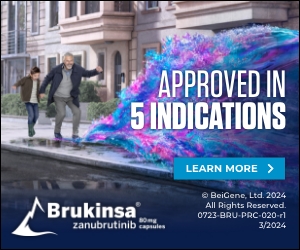Bispecific antibodies represent a new approach to cancer immunotherapy that offers a two-for-one mechanism of action to increase efficacy in treating several types of lymphoma and multiple myeloma and other hematologic malignancies.
These engineered proteins simultaneously bind to two different antigens or epitopes. This dual targeting capability recruits immune effector cells, T-cells, from the periphery to attack tumor cells. In B-cell lymphomas, bispecific antibodies (BsAbs) target a B-cell-specific antigen, such as CD20, and simultaneously bind to CD3 on T cells, enhancing T-cell activation and proliferation.
At the 2024 Association of VA Hematology/Oncology (AVAHO) annual meeting, Andrew Ip, MD, a hematologist with the Hackensack University Medical Center, discussed the use of epcoritamab-bysp, a bispecific antibody FDA-approved for treatment of diffuse large B-cell lymphoma (DLBCL) in the third or subsequent lines and for relapsed or refractory follicular lymphoma.
DLBCL and follicular lymphoma are presumptive conditions for veterans exposed to ionizing radiation, those exposed to Agent Orange, and veterans who served in the Gulf War or after 9/11 in the Southwest Asia theater of operations, Somalia, Afghanistan, Djibouti, Egypt, Jordan, Lebanon, Syria, Uzbekistan or Yemen. Follicular lymphoma is also a presumptive condition for veterans exposed to contaminated water at Camp Lejeune.
Epcoritamab showed promising efficacy in treating B-cell lymphomas in the EPCORE NHL-1 trial, with overall response rates reaching 82% for follicular lymphoma with 60% achieving complete response (CR), and 61% for DLBCL (diffuse large B-cell lymphoma), with 38% achieving complete response.
For patients who achieve CR, the duration can be significant, Ip noted. “Even patients with a partial response may experience significant clinical benefits, as they often have no symptoms of their disease.”
Epcoritamab is administered subcutaneously. The treatment regimen involves a step-up dosing strategy, with very small doses given initially, followed by a full dose starting in week three. This approach helps mitigate the risk of cytokine release syndrome (CRS).
Clinicians should inform patients that, after the first cycle, if no grade two or higher CRS or immune-related adverse events occur, they do not need premedication for subsequent doses. “The three milligram and 48 milligram doses do not require dilution,” Ip noted, streamlining the preparation process for healthcare providers.
Management of CRS and Neurotoxicity
Ip focused on the safety profile of epcoritamab, with approximately 50% of patients experiencing any grade of adverse reactions. Importantly, only around 2.5% experience grade three reactions, which may require intensive care. Common side effects include including abdominal pain and rash. Most patients feel fatigue, Ip said: “That’s the most common thing I hear from my patients: they feel tired, but they’re usually still able to function and perform their activities of daily living (ADLs).”
CRS is a primary concern with bispecific antibodies. It occurs in about half of patients treated with epcoritamab, typically presenting as mild to moderate symptoms. Ip said that “over 90% of CRS events happen within the first month,” necessitating close monitoring, especially during the initial dosing period, and are uncommon once the therapeutic dose is reached.
Unlike other therapies, hospitalization for epcoritamab administration is not required for third-line follicular lymphoma patients due to observed safety outcomes: “We saw 0% grade three or grade four CRS and no neurotoxicity.” However, it remains prudent to hospitalize selectively for certain reactions.
Effective management of CRS involves following established guidelines. Grade one CRS typically requires monitoring, while grade two involves withholding treatment and possibly re-hospitalizing the patient if symptoms persist. For more severe grades, such as grade three and four, the guidelines recommend discontinuing treatment altogether and considering aggressive intervention.
Neurotoxic effects, assessed using a cognitive evaluation tool, are another potential side effect. Monitoring patients for signs of confusion or disorientation is crucial. As described, “These are patients who may need significant support and monitoring,” especially if they exhibit grade two or higher neurotoxicity.


